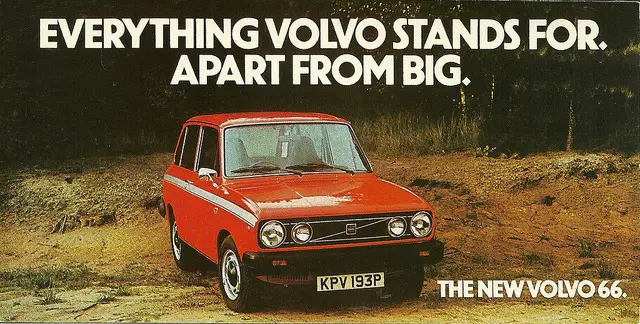DO YOU REMEMBER – THE VOLVO 66?
21 February 2023
We could have equally called this blog “Twilight Under Another Marque”, as several long-running models ended their careers with a different marque name. The Chrysler Hunter falls into this category, as does the Dodge Spacevan and the final DAF saloons, which were sold as Volvos in their last five years of production.
This name change occurred after DAF initiated its P900 hatchback project in the early 1970s. It was an ambitious plan that needed a partner, so the Dutch firm approached Audi and BMW before signing an agreement with Volvo, who took a majority share in the concern by 1975. As a result, when the P900 made its bow in the following year, it was as the ‘343’ produced by Volvo Car BV of The Netherlands.

Meanwhile, DAF’s mainstay, the 66, gained a new identity as a Volvo in 1975. British sales commenced that August, and the concessionaire imported only the GL version, which they promoted as “The Start of Something Small”. The rebranding included new bumpers and a more comfortable interior - Motorist’s Guide magazine noted the luxury of PVC door trims.
The motoring correspondent for The Guardian thought it had the best automatic transmission he had ever experienced, and the 66 was also rather nicely appointed. Front and rear inertia belts, two-speed wipers, a cigar lighter, front head restraints, electric windscreen washers, and twin Halogen spot lamps certainly gave the small Volvo showroom appeal.
However, the 66 was rather expensive. By 1976 the Saloon cost £2,283, and the Estate was £2,449, while a Vauxhall Chevette GLS was £2,198, and a Chrysler Avenger 1600 Super was £2,164. When production ended in 1980, only 14,000 had found a home in the UK. But it could be argued that the 66 was a car for a niche market. The rebranding gave the sense that here was the ideal second car for a family with a 244. One advertisement claimed, “In designing, engineering, and assembly of the 66, we’ve been as meticulous as with any other Volvo”.
Perhaps the best way of describing the 66 is to say it was ideal for the motorist who drove a Riley Elf or Wolseley Hornet ten years earlier. As one sales campaign memorably said, here was “a sensible car for sensible people”.
